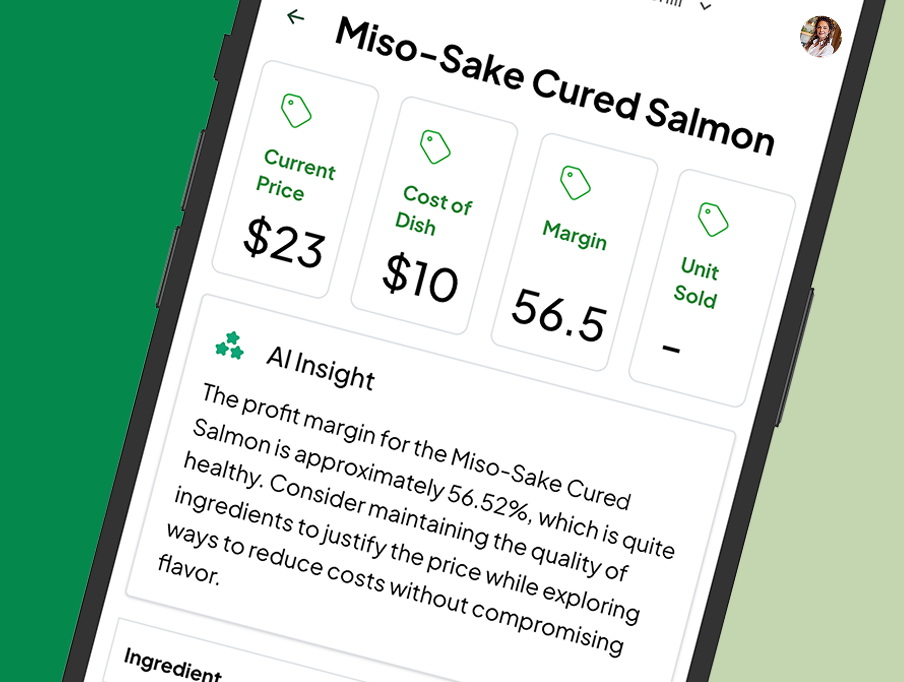You’ve got a sizzling steak on the grill, seasoned to perfection, plated with care, and served with a side of crispy fries or roasted vegetables.
Your customers love it, your chefs take pride in it, and it’s one of your best-selling dishes. But here’s the big question: Are you actually making money on that steak?
Many restaurant owners assume their menu pricing is solid—until they run the numbers. Without a strategic approach to pricing, even your most popular dishes could be losing you money. That’s why understanding the real cost of each plate and pricing accordingly is crucial to your restaurant’s success.
At MRGN, we help restaurant owners like you take control of your numbers without needing a finance degree. Let’s break down how to price your dishes for maximum profit and avoid the common pitfalls that could be draining your bottom line.
The Hidden Costs Behind Every Dish
The true cost of a dish is more than just the price of ingredients. If you’re only looking at the cost of that steak alone, you’re missing a huge piece of the puzzle.
Here’s what goes into the real cost of that steak dinner:
1. Cost of Goods Sold (COGS)
This is your direct ingredient cost, which includes:
- The steak itself: Whether it’s a ribeye, filet mignon, or sirloin, beef prices fluctuate regularly.
- Seasonings and marinades: Salt, pepper, butter, garlic, and any special sauces add up.
- Side dishes: Fries, mashed potatoes, roasted veggies, or a side salad.
- Garnishes: That sprig of rosemary or truffle oil drizzle isn’t free.
If your COGS is too high, your profit margin shrinks. If it’s too low, customers may question the quality. The sweet spot? Your COGS should be around 28-35% of the menu price for a profitable dish.
2. Overhead Costs
Beyond ingredients, every plate contributes to covering your fixed costs:
- Rent and utilities
- Staff wages (chefs, servers, dishwashers)
- Kitchen equipment maintenance
- Marketing and promotions
If you don’t factor in overhead, you may price your steak too low, making it impossible to cover these expenses.
3. Waste and Shrinkage
Did you know that the average restaurant wastes between 4-10% of purchased food? Trimming fat off steaks, spoilage, and incorrect portioning all impact costs. If you don’t account for waste, you’re underpricing.
How to Price Your Steak (or Any Dish) for Profit
Now that you know the real cost of a dish, how do you price it smartly? Here’s the formula successful restaurants use:
Step 1: Calculate the Ingredient Cost Per Plate
Let’s say your 12 oz ribeye steak plate includes:
- Steak: $8.00
- Seasonings and butter: $0.50
- Mashed potatoes: $1.50
- Vegetables: $1.00
- Garnishes: $0.25
- Total COGS: $11.25
Step 2: Apply the Right Pricing Formula
The standard pricing method for restaurants is to set menu prices at 3-4x the ingredient cost.
If you want a 30% food cost ratio:
$11.25 ÷ 0.30 = $37.50 (suggested menu price)
If you want a 35% food cost ratio:
$11.25 ÷ 0.35 = $32.15
Your final price depends on your brand, market, and competition. If you’re a high-end steakhouse, $45 might be reasonable. If you’re a casual dining spot, $28 might be more realistic.
Step 3: Factor in Overhead and Labor
If your food cost is 30%, where’s the rest of the price going?
- 30-35% goes to labor costs
- 20-25% goes to overhead (rent, utilities, marketing, etc.)
- 10-15% should be profit
If labor costs in your area are high, you may need to increase menu prices or optimize your staffing model to maintain margins.
Common Pricing Mistakes That Kill Profits
Even if you follow the formula above, there are some pricing traps that can eat away at your bottom line. Avoid these mistakes:
1. Not Updating Prices to Match Rising Costs
Ingredient prices fluctuate constantly. If beef prices jump by 20%, but your menu prices stay the same, you’re absorbing the cost instead of passing it along.
Solution: Use MRGN to track COGS in real-time and adjust menu prices accordingly.
2. Ignoring Portion Control
Over-serving leads to higher food costs and more waste. If your kitchen serves 14 oz of steak instead of 12 oz, your profit margin is shrinking with every plate.
Solution: Standardize portions and train staff to be consistent.
3. Pricing Based on Gut Feeling Instead of Data
Many restaurant owners set prices based on competitors or intuition, rather than actual cost analysis. This can lead to underpricing (losing money) or overpricing (losing customers).
Solution: Data-driven pricing ensures you make money while staying competitive.
4. Discounting Too Heavily
Happy hour specials and promotions can drive traffic, but discounting too aggressively can eat into profits fast.
Solution: Only discount low-cost, high-margin items—not expensive steaks.
How MRGN Helps You Get Pricing Right
Running a restaurant is hard enough without stressing over spreadsheets. That’s why MRGN helps you:
- Track real-time ingredient costs—so you can adjust pricing before it’s too late.
- Identify your most profitable dishes—so you can promote them more.
- Predict future cost changes—so you’re never caught off guard by price hikes.
- Optimize labor costs alongside menu pricing—so you don’t just break even, but thrive.
The right pricing strategy isn’t about guessing—it’s about understanding your costs, setting smart margins, and making data-driven decisions.
Price Smarter, Profit More
That steak on your menu isn’t just a meal—it’s a financial decision. Every dollar counts, and without the right pricing strategy, even your best-selling dishes could be hurting your bottom line. By tracking costs, setting smart margins, and staying proactive with pricing adjustments, you can turn every plate into a profit driver.
With MRGN, you don’t have to crunch the numbers manually or rely on guesswork. Our platform gives you real-time insights into your costs and profitability, so you can make informed pricing decisions—without an accounting team or CFO.





